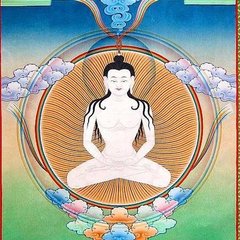-
Content count
11,758 -
Joined
-
Last visited
-
Days Won
272
Everything posted by steve
-
In my mind, this is a different issue. This example is more related to rules and consequences. The master of a lineage does not need to feel forgiveness for the precept-breaker, they need to enforce the rules in order to preserve the tradition or insure optimal training. I can forgive someone and still expect them to be appropriately punished. The master can feel genuine compassion and forgiveness and still exact punishment in order to teach a lesson. The forgiveness is in my heart, the punishment is an attempt to modify behavior, two very different things for me.
-
Another important consideration here applies to those of us following spiritual paths like Bon, Buddhism, Advaita Vedanta, and so on. Forgiveness and repentance are associated with the sense of a finite and persistent self. If we are able to release ourselves from the captivity of that limited idea of self, forgiveness and repentance are spontaneous and effortless. The degree to which we feel wronged, or that we have wronged, is the degree to which we remain attached to a finite sense of self. So the process of releasing and opening into the present moment, free of the baggage of expectations and judgement, naturally leads to forgiveness that is not dependent on repentance and to contrition that is not dependent on forgiveness. These are all must my own personal musings and I don't suggest or expect that my approach will work for others. Just sharing where I'm at on my journey, fwiw.
-
Forgiveness, for me, is a personal and private act of releasing the pain and bitterness of perceived offense. It has little to do with anyone else or their choices. It allows me to diminish my own burden, if genuine. Repentance or contrition is also a personal and private act of releasing the burden of having offended myself or others. It allows me to diminish my own burden, if genuine. If I depend on someone else’s repentance to consider forgiveness, or vice versa, I am only harming myself, no one else, withholding the possibility of healing and growth. My sustained experience of offense and the associated stress only harms me, it does nothing to my offender. Maya Angelou has some beautiful statements and poetry about the subject. The film Rubaru Roshni is a beautiful and touching film about forgiveness, highly recommended.
-
https://www.netflix.com/title/81243992
-
The other problem is that this deluded mindset can be a source of abusive behavior. There is a dzogchen saying that states 'the view should be as broad as the sky but the conduct as fine as barley powder.' When behavior comes from a genuine connection to the source, there is little or no possibility of abusive behavior. When it comes from the deluded mind, bad actors misbehave. These are some of the reasons why the dzogchen path was kept so secretive for so long, there is a higher potential for misunderstanding, and related abuse, than with other paths.
-
It's OK To Not Be OK is one of my favorite Korean dramas, highly recommended!
-
This reminds me of a favorite pith instruction from Anthony Demello - 'Pleasant experiences make life delightful, painful experiences are opportunities for growth.'
-
I love this angle! I appreciate the orthodox version but always enjoy finding connections between traditions. For me the meaning is not in the text, it’s in the reader.
-
Did you mean to say ‘does not’?
-
The dzogchen path that I follow is one that is guilty of using such terminology. Dzogchen literally means great (chen) perfection (dzog). As Keith suggests, to the Western ear a more palatable and equally valid translation would be great completion. In this context, perfect or complete does not imply a value judgement from the human perspective. It is more a recognition of the spontaneous presence of all enlightened qualities in our natural mind, always present and awaiting discovery. It suggests that we don't need to add or subtract anything or change anything to have access to unlimited potential for enlightened activity. We simply need to be open and unimpeded by our tendency to "collapse the wave function" (to borrow some quantum mechanics language); by our tendency to over-identify with a limited sense of "me" that excludes so many possibilities. For me this has strong parallels in Daoism, a few examples being concepts like ziran and wuwei, as well as the idea that Heaven, Earth, and the sage not being humane/benevolent but regarding people as straw dogs. In attending many dzogchen retreats over the past decade or so, this is one of the areas that causes the most consternation and frustration among developing practitioners. Of course there are many terrible things in the world, people suffer greatly and this is absolutely acknowledged in dzogchen and serves as the very basis and purpose for engaging in practice - namely, to liberate one's own being in order to benefit others. From the perspective of the samsaric being, the world can be a very tough, unforgiving, and dangerous place. From the absolute perspective, everything that arises is simply a function of the workings of karma and dependent origination. There is a sense of perfection or completeness in terms of the fact that if anything is changed, everything else changes. Nothing can be added or taken away or things would not be as they are. In this sense the whole is perfect and complete. I wonder if there is a parallel in Hindu systems relative to the inherent perfection/completeness of Brahman relative to the incompleteness and imperfection of maya... or something like that?
-

Reincarnation, the soul, Hinduism and Buddhism
steve replied to Haribol's topic in General Discussion
One way to think about it is in distinguishing the concept of reincarnation from rebirth. Reincarnation implies a permanent, self-sustaining entity, atman, that transmigrates from one incarnation to another. Rebirth implies the coalescence of mental and physical aggregates, which arise as a result of karma and dependent origination, in a new form in the absence of an eternal soul. I'm not saying one is right and one is wrong by any means, both are simply attempts to capture mystery in concepts and words. I think rebirth is closer to what is described in Buddhism and reincarnation in Hindu systems. In terms of the soul, I can't say that I have a personal take per se but I do resonate with the Bönpo concept of "bla" which is the closest thing in the system to the Western idea of soul. Truth is, it is not equivalent to soul but an interesting take on the basic idea. If you have the time and patience, this video does a nice job of exploring it - -
not from beyond or apart from, that's not what is meant. the mind's nature is open and clear, the mind refers to all of the contents, perceptions, formations, activities, etc... here's a brief excerpt from a Bön teaching that helps to distinguish - As for recognizing the mind and the nature of mind: Free of thoughts, Becoming the base-of-all, Neutral, Possessing the potential to arise as anything without ceasing - These four. The base-of-all is the nature of mind. Recollected and aware, Able to arise as anything whatsoever, Liberated when released, If allowed to settle, it mixes [with the base-of-all] - These four. The intellect is the mind. The method is that you hear this teaching, try to understand the meaning as best you can, then actualize this understanding in practice, traditionally in an extended and isolated retreat. Then the teacher checks your understanding and corrects or guides as needed. mind is not the ultimate self in these teachings probably, it's a tough subject to casually talk about, the vast majority of this process of "introduction to the nature of mind" is experiential practice, the metaphors, similes, examples, and descriptions are cognitive tools to help guide and correct when needed. yes agree, I'll stop here
-
This is perhaps the most important discernment in dzogchen. What is the mind, what is its nature or essence, and how are the two distinguished and how do they relate to the self and ultimate reality? The ways of teaching this can be complicated because different people require different things to "get it." It's not a conceptual or intellectual definition because that is still the territory of the mind, which generally considers itself the only tool available for "understanding," not yet trusting anything outside of its realm, and yet not appreciating its own limitations when considering that which may be beyond its grasp. So there are several methods, often relying on simile and metaphor as well as meditative methods. This might be a topic for a different thread.
-
And another soul that needed to get a little crazy!
-
Your image doesn't come through for me but there certainly is quite a bit of flamboyance in the Bön traditions. The sounds, smells, costumes, iconography, stupas - lots of beautiful stuff (if you're into that sort of thing). There are "nine ways" according to the old Bön tradition which I reference below. The first four are referred to as "causal vehicles" and are closely related to the shamanic roots of Bön and working with natural forces, elements, and energies and such. The 5th and 6th vehicles are related to the sutric paths (paths of renunciation, working with one's body, speech, and mind to reject samsara and strive towards liberation through prayer and mind training primarily). The 7th and 8th are the "tantric" vehicles. In this group we find many practices that I think are closest to what you are describing as "active meditation." Practices developing relationships with meditational deities (yidams) and elemental goddesses (dakinis) and becoming intimately familiar with all of their associations, visualizations, rituals, offerings, mudras, mantras, behaviors, etc... When I think of and refer to "active meditation," it is in the context of the 9th vehicle. These are not "active" practices per se but are an application of dzogchen practice to every activity imaginable. Life becomes the practice. The core practice, as I think you know, is to recognize the nature of the mind and eventually identify with this as one's ultimate "self." In this context, active meditation ultimately means that one remains fully connected with the mind's pure essence throughout every waking, active, sleeping, dreaming, and dying moment. The practice is to first establish stability and continuity in formal practice on a cushion in a quiet place, undisturbed. When stable enough, we try to find that connection, and eventually some stability and continuity, while engaged in "righteous" and "supportive" practices like reciting mantras, circumambulating sacred sites, reciting prayers, and so on. When that is successful, we move on to more mundane daily activities like eating, cleaning, sex, and so on. Finally, we challenge ourselves with activities that would typically take us far out of that space - emotional and painful situations, jobs that involve creating harm (like butchery), fighting, and so forth. These categories are not mutually exclusive. Most practitioners are engaging with practices from different vehicles at any given time in their life depending on what is needed and how they are progressing. Tantric practitioners also practice with the nature of mind but do not consider that enough in and of itself and engage in transformative practices with the assistance of meditational deities. The 9th vehicle focuses exclusively on the nature of mind and states that the results of all other vehicles are accessible when this practice is done properly. The Nine Ways of Bön according to the Southern Treasures: (quoted from https://ravencypresswood.com/2013/02/24/what-are-the-nine-ways-of-bon/) 1. The Way of the Shen of Prediction: This Way includes divination, astrology, various rituals, and medical diagnosis. 2. The Way of the Shen of the Phenomenal World: This Way includes rituals dealing with communication with external forces such as rituals of protection, invocation, ransom of the soul and life-force, and of repelling negative or harmful energies. 3. The Way of the Shen of Manifestation: This Way includes venerating a deity or master and then applying mantra and mudras in order to accomplish a goal such as requesting assistance from natural energies. 4. The Way of the Shen of Existence: This Way is primarily focused upon rituals for the dead and methods to promote longevity for the living. 5. The Way of the Virtuous Lay Practitioners: This Way specifies the proper conduct of lay person taking vows. 6. The Way of the Fully Ordained: This Way specifies the proper conduct for those who are fully ordained practitioners. 7. The Way of the White AH: This Way is primarily focused upon tantric practice using visualization. 8. The Way of the Primordial Shen: This Way is primarily focused upon higher tantric practice. 9. The Unsurpassed Way: This Way is primarily focused upon the practice of Dzogchen, or The Great Perfection. This Way does not rely upon antidotes of any kind, ritual or practice with a meditational deity. It is concerned with the realization of the true nature of one’s own mind.
-
Not sure if it's comparable to this but I practice a method called turtle-crane breathing. My teacher told us it was a longevity practice.
-
There is an interesting Bönpo practice that is intended to actively exhaust the thinking mind so that it can release into stillness. You reflect on actions of the body, speech, and mind (each individually), taking enough time to really feel and pay attention to how much energy and effort have been expended over time, going as far back in memory as possible. Take as much time as necessary to get a sense of the shear magnitude of all of that expended effort and energy. When the experience reaches a peak and feels overwhelming, you simply let all of it go and rest in the stillness, silence, and spaciousness of the present moment, similar to the feeling of returning home from a long journey or exhausting day of work and settling into your favorite chair or bed and fully allowing body and mind to rest. It's a powerful technique.
-

Personal Practice Discussion Thread Request
steve replied to Henchman21's topic in Forum and Tech Support
Working with PPD's is tricky, especially on a Mac. I remember accidentally moving threads to the wrong PPD on more than one occasion. Thanks for your help. -

Personal Practice Discussion Thread Request
steve replied to Henchman21's topic in Forum and Tech Support
Hi mods, I noticed that there are threads in my PPD that seem to have been moved there unintentionally. Not a problem for me but I thought you should know in case someone else is looking for their content. Attached is a screenshot of my current PPD front page. The only threads I created for my PPD are "Yungdrung Bön" and "Music." The others are not mine. Thanks -
I decided to combine my meditation and martial arts practices for efficiency so I'm now studying Jackie Chan.
-
I always appreciate your clarity and candor! 🙏🏼
-
One very important, though subtle, difference is the presence of the one who is trying to get something, trying to realize something. The trying is effortful, it betrays a deep belief that we are not enough as we are and that something must be changed in us.. That sense of inadequacy is a formidable obstacle to the meaning and manifestation of enlightenment, in the dzogchen sense. The view of dzogchen, similar to that of Zen, is that enlightenment needs nothing to be added or taken away. This is also reflected in the practice, behavior, and ultimate fruition. The view is that we have everything we need already, we simply need to relax into the fullness. openness, and infinite potential that always is right here and right now. The Bönpos refer to the source of enlightenment as Kuntuzangpo which literally means all good, as in cannot be improved upon in any way.





